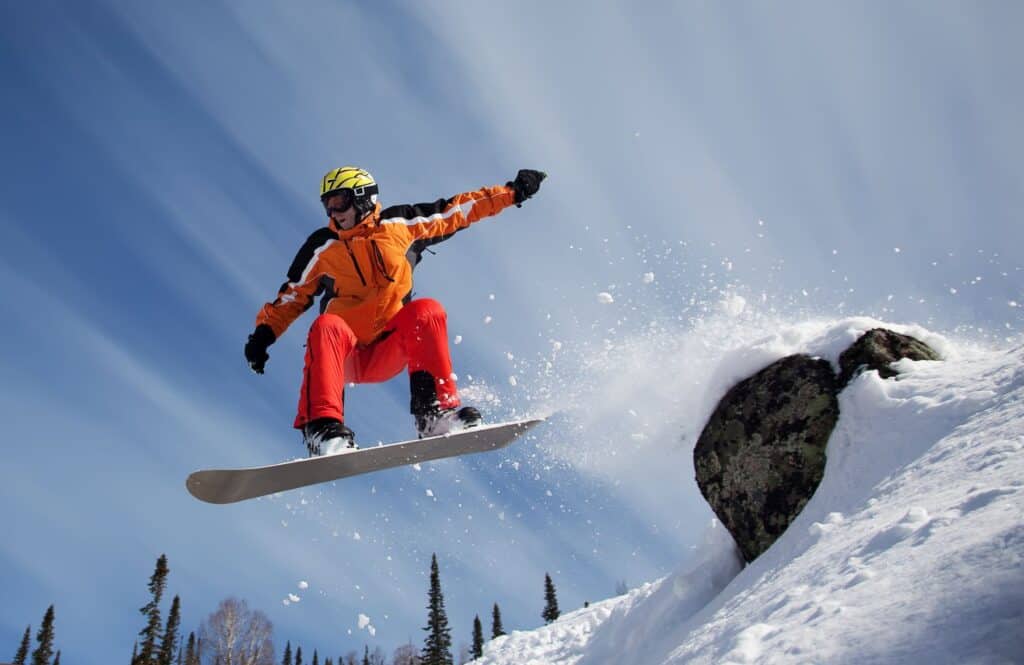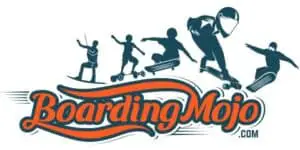There are many similarities and differences between snowboarding and skateboarding, many people that enjoy one sport can likely pick up the other with ease! The most notable difference between these two creative outlets is snowboarding is done in the winter months requiring snow. In contrast, skateboarding is generally done in the warmer or more temperate months of the year.
Many places in the world offer the chance to go skateboarding year-round thanks to indoor parks or compounds. For those that grew up either skateboarding or snowboarding and are looking to venture into the unknown of the other sport, we are here to help!
Both sports require finely tuned muscles developed over years of practice to become completely comfortable on a board. In this article, we will go through the similarities and differences between these two sports to give an accurate overview of the skills and resources required.
Snowboarding Equipment
Snowboarding has been around since the 1960s – 1970s, evolving tremendously in both skills and equipment standards. A snowboard is a large flat board with a nose and tail designed to push and carve through the snow. Typically, your snowboard size is based on your height and weight to provide the most stability along with better control.
Bindings
Bindings are bolted in place on a snowboard at the desired angle depending if your ride “goofy” or “regular. The goofy stance is when you feel most comfortable riding with your right foot forward, while the regular stance is for those that prefer to ride with their left foot forward. Choosing your stance will determine the angle at which your bindings are angled.
Boots
Snowboarding boots are specially designed to provide maximum ankle support to reduce injury while giving you optimal control over your snowboard. Boots are strapped into the bindings and locked in place, preventing the rider from lifting their feet out of position. This may be the most significant difference between skateboarding and snowboarding. With skateboarding, you can freely move your feet around the board.

Skateboarding Equipment
Skateboarding first became popular in California, giving surfers an alternative to surfing when the waves are undesirable. What started as an unconventional pastime soon became a worldwide phenomenon making its way into the Olympics. Much like snowboarding, skateboarding equipment has changed drastically from where it began with many innovations in style, quality, and longevity.
Skateboards come in many different shapes and sizes based on your riding preferences. Cruiser boards, longboards, penny boards, electric skateboards, and the classic skateboard shape all serve other purposes.
Cruiser Boards
Cruiser boards are wide skateboards with a large wheelbase to accompany big soft wheels. This style of board is designed with its name in mind, cruising! Getting from one place to the other or just going out for a relaxing ride is the perfect scenario for using a cruiser board. These boards typically have an angled tail in the back and a short pointed nose.
Longboards
When speed and stability are what you’re after, a longboard may be the perfect choice for you! This skateboard style is comparatively much longer and flatter than other skateboards, making it great for carving downhills. Longboards have large soft rubber wheels to roll over cracks and debris with ease. Most longboards are completely flat along the entire deck, lacking an angled nose or tail.
Penny Boards
Much like cruiser boards, penny boards are the trendy younger brother! Penny boards are much smaller than the other types of skateboards mentioned above, making them an excellent choice for those living in a city or cruising around a college campus. Unlike all other types of skateboards, penny boards are made entirely from plastic. This allows them to remain lightweight and easily manageable for people of all ages.
Classic Skateboard
The most popular skateboard style is the classic skateboard or trick board, as referred to by most. A trick board features an angled nose and tail for performing tricks and maneuvers off of both. The board’s nose and tail are angled in such a way to provide scoop and pop when attempting a trick. These boards are made from many different plies of wood to provide maximum durability while being extremely flexible. This skateboard style is typically fitted with smaller hard polyurethane wheels to sit lower to the ground, aiding in performing tricks. For those transitioning from snowboarding to skateboarding, the trick board is the most similar in shape and design to a snowboard. While not the best option for riding long distances, the trick board is the most versatile.
Trucks & Wheels
Once you have chosen your style of skateboard, trucks, and wheels are next! Trucks are the metal “T” shaped device that holds your wheels in place and are bolted into the skateboard. Bushings allow the trucks to move freely back and forth for making turns or carving around a bowl. Your truck size is determined by the size board you are riding, and the same goes for choosing your wheels. Bearings are what make your wheels rotate smoothly and are available in a wide range of speed options.

Snowboarding Vs. Skateboarding: The Movements
Now that we have covered the basics behind snowboarding and skateboarding equipment let’s talk about the actions and motions of both.
In both sports, you are standing sideways on the board as it moves forward. Many riders prefer which foot should be put towards the front of the board, called your stance like mentioned above. While some riders will ride “goofy” on a skateboard and “regular” on a snowboard, it is common that your stance will be the same for both. This helps aid the transition from snowboarding to skateboarding as it is the most common similarity between the two activities.
For snowboarders and skateboarders alike, you turn the board in any given direction based on how you adjust your body weight. Leaning towards your toes will turn the board one way, while leaning back on your heels will maneuver the board in the opposite direction.
Riders can slow the snowboard’s speed by pushing the board 90 degrees in either direction, putting the board perpendicular to the bottom of the mountain. This motion will work just as effectively for skateboarders, although the most common way of slowing down is by leaning your weight onto the back foot and scraping the tail against the ground.
The Culture
Blasting music and baggy clothes are just the tip of the iceberg when it comes to snowboard and skateboard culture. Ever since the creation of both sports, there have been many adversaries and rules to reduce the places that these activities can be done.
When snowboarding first came onto the snow sports scene, skiers and ski mountains alike saw snowboarding as a fleeting fad made for delinquents. Although not true, this stigma led to the ban of snowboarding across the world and put a bad taste in people’s mouths. This stemmed from novice snowboarders going up the biggest mountains and unable to control their speed or trajectory and plow into experienced skiers. Even today, many people do not like snowboarders being near them on a mountain and will verbalize these feelings every chance they get.
Skateboarding has undergone the same prejudices in the streets and metropolitan areas, often leading to the police being called for participating in a beloved sport. Many businesses and pedestrians see skateboarding and skateboarders as destructive and obnoxious, due very much to the loud sound riding a skateboard makes.
Conclusion
While there many fundamental differences between hopping on a skateboard and being strapped into a snowboard, the motions involved are very similar! These similarities make it easier for a skater to transition into snowboarding and vice versa. Needless to say, if you grew up skiing and decided to try your hand at skateboarding, you may have a harder time adjusting when compared to someone who grew up snowboarding.
All snowboarders and skateboarders love being outside in the elements. No matter your riding style or gear preferences, these two sports offer a little bit of everything for anyone interested in getting started. Do your research! See what best fits your lifestyle, and most importantly, have fun!
If this article was helpful, sign up for our Newsletter for more great content.

